Introduction: A New Era of Mobility in the Emirates
The UAE is accelerating toward a greener and smarter future, and General Motors (GM) is playing a pivotal role. With the launch of GM electric vehicles in the UAE—including the high-performance GMC Hummer EV and the elegant Cadillac Lyriq—a major step is being taken towards sustainable, tech-driven mobility.
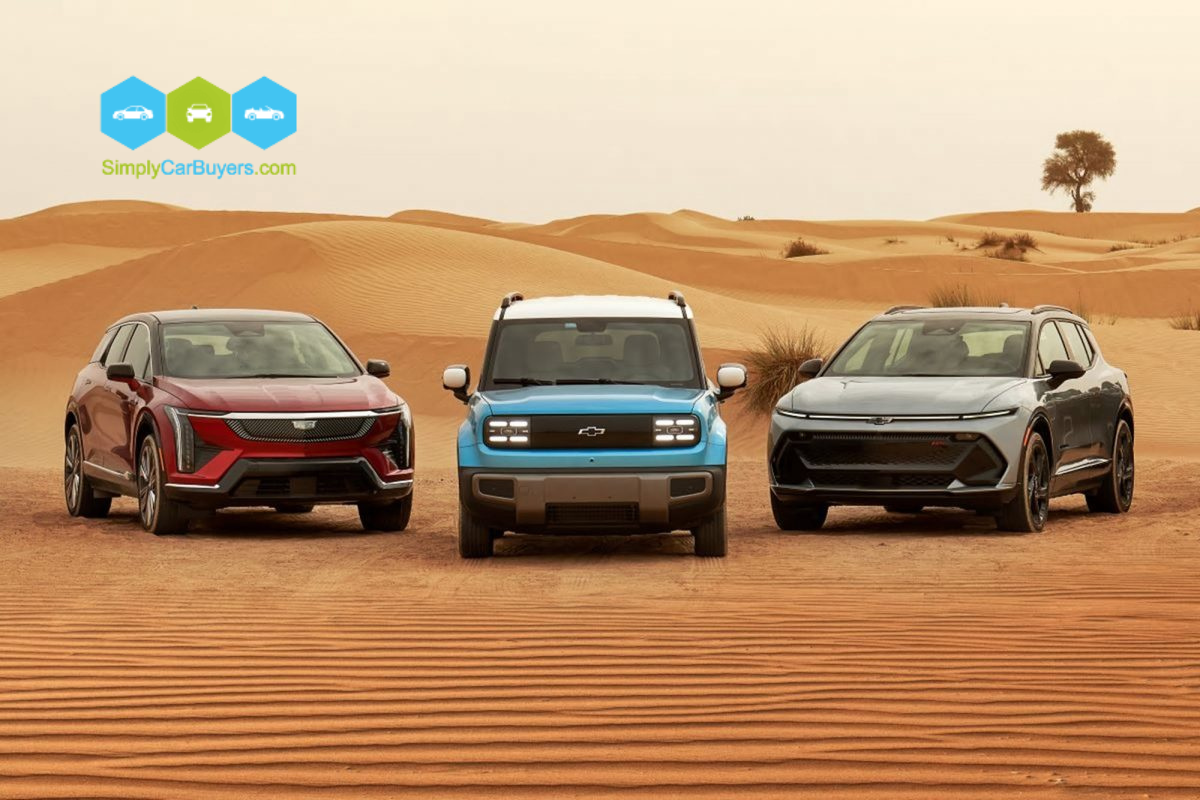
The Importance of GM electric vehicles in the UAE
Why are GM electric vehicles in the UAE important? Simply put, they align with the country’s national vision for clean and smart transportation. With initiatives like Dubai’s Clean Energy Strategy 2050, these vehicles aren’t just convenient—they’re part of a broader movement toward a sustainable lifestyle.
GMC Hummer EV: Power Meets Innovation
The Hummer EV is no longer a fuel-guzzler—it’s an electric powerhouse. Boasting 1000 horsepower, it accelerates from 0 to 100 km/h in approximately 3 seconds. Off-road fans will appreciate the CrabWalk feature, which allows diagonal movement for superior desert navigation.
Smart and Sophisticated Interior I
nside, the Hummer EV combines robust utility with high-end finishes. Digital displays, premium materials, and advanced controls offer a futuristic experience. Even more impressive,
it charges up to 160 km in just 10 minutes using DC fast chargers.
Cadillac Lyriq: Electric Elegance on Four Wheels
The Lyriq introduces luxury to the EV market. With a 33-inch curved LED screen, Super Cruise hands-free driving, and immersive audio, this SUV redefines comfort and innovation.
Active Noise Cancellation ensures a silent ride, adding to the premium feel.
Extended Range and Fast Charging
Function meets style in the Lyriq. Capable of driving over 500 km on a full charge, it is well-suited for long journeys across the UAE. Thanks to fast-charging tech, you can hit the road again with minimal wait time.
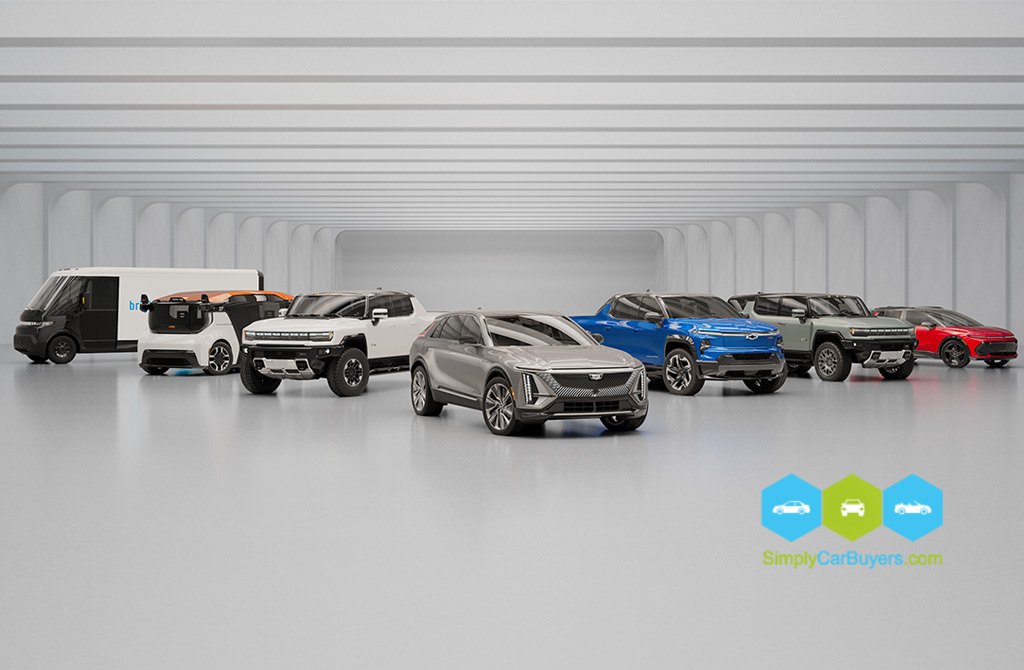
EV-Friendly Policies in the UAE
The UAE government supports EV adoption with free public charging, discounted registration, and special parking spots. These incentives, coupled with initiatives like Abu Dhabi’s electric. taxi fleet, make EV ownership highly appealing.
GM’s Future Plans and the UAE’s Role
By 2025, GM plans to launch 30 new electric models globally. The UAE is a priority market, benefiting from early access to models across the Chevrolet, GMC, and Cadillac brands. This includes options for every kind of driver.
GM electric vehicles in the UAE: Why Ultium Batteries Matter
All GM electric vehicles share the Ultium battery platform. This tech offers longer range, better performance, and affordability. It powers everything from high-end SUVs to practical sedans. Explore GM’s EV technology.
Upgrade Easily with Simply Car Buyers Ready to switch to electric? Simply Car Buyers makes it easy. Get a free online evaluation, receive instant offers, and enjoy a seamless selling process for your current vehicle.
Check our EV blog insights or learn how to sell your car fast.
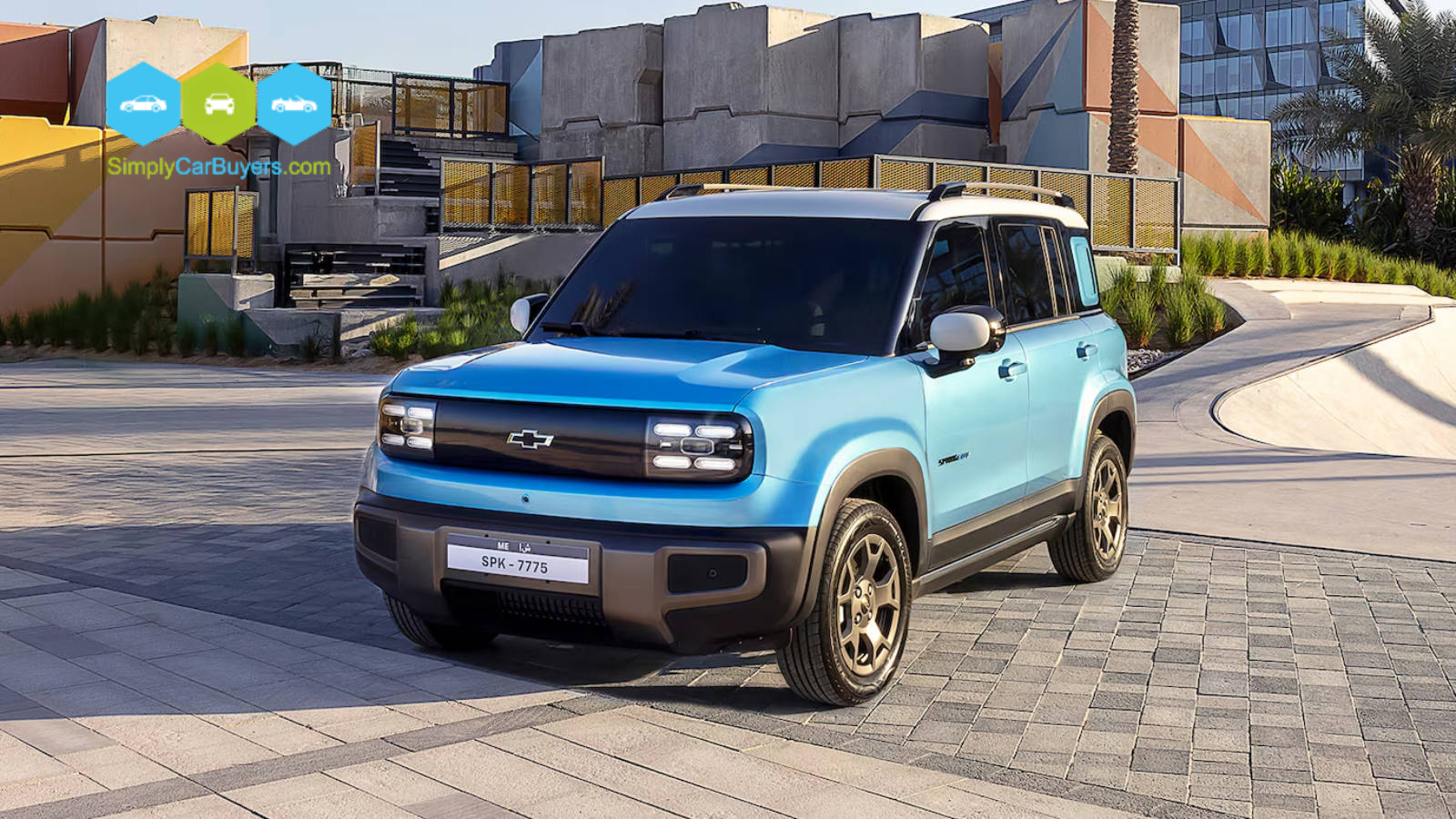
Conclusion: GM electric vehicles in the UAE
GM electric vehicles in the UAE represent more than just transportation—they represent a lifestyle shift. Whether it’s the powerful Hummer EV or the luxurious Lyriq.
these cars symbolize the country’s progress in sustainable innovation. With growing EV infrastructure and market demand, the UAE is well-positioned to lead the region in electric mobility.

Toyota Aygo X in UAE – Smart Urban Crossover
/in General /by SimplyCarBuyers.comToyota Aygo X – Designed for Urban UAE Roads
City driving in the UAE comes with unique challenges: tight spaces, traffic, and high temperatures. The Toyota Aygo X (pronounced “Aygo Cross”) delivers a smart solution—blending compact agility with crossover style and Toyota reliability. While it launched in Europe in 2022, the Aygo X arrived in the GCC in 2025, offering a city-friendly alternative to bulky SUVs.
This article highlights everything UAE drivers need to know—from engine specs and design features to pricing, maintenance, and how Simply Car Buyers can simplify selling your old car.
Key Specs of the Toyota Aygo X
Weighing just under 1,000 kg, the Aygo X zips through city roads with ease—perfect for places like Al Barsha and Al Zahiyah.
Style and Comfort on UAE Streets
Urban-Friendly Seating
A higher driving position enhances visibility, especially in crowded city environments.
Eye-Catching Paints
Dual-tone options like “Cardamom Green” or “Chilli Red” make a statement, day or night.
Canvas Roof Option
The GCC Limited variant features a retractable roof—ideal for evening drives near the Corniche.
Efficient and Durable Performance
Real-world fuel use ranges from 18–19.5 km/L depending on driving style and conditions.
Technology and Infotainment
Comprehensive Safety Suite
The Aygo X scored 4 stars in Euro NCAP tests—meeting GCC safety needs.
Smart Interior Layout
Rivals Compared
The Aygo X outperforms competitors in fuel savings and long-term value.
Cost of Ownership in the UAE
Ideal Buyers for the Aygo X
Buying Advice
Learn More:
Sell Your Car Today with Simply Car Buyers
Ready for a change? Sell your car quickly and easily in Dubai or Abu Dhabi. With Simply Car Buyers, you get fast service, free valuation, and secure pickup.
👉 Start selling now at SimplyCarBuyers.com
📞 Call: 800 25
📧 Email: info@simplycarbuyers.com
📱 Follow us on Facebook for tips and support.
GM Electric Vehicles in the UAE | Hummer & Lyriq EVs
/in General /by SimplyCarBuyers.comIntroduction: A New Era of Mobility in the Emirates
The UAE is accelerating toward a greener and smarter future, and General Motors (GM) is playing a pivotal role. With the launch of GM electric vehicles in the UAE—including the high-performance GMC Hummer EV and the elegant Cadillac Lyriq—a major step is being taken towards sustainable, tech-driven mobility.

The Importance of GM electric vehicles in the UAE
Why are GM electric vehicles in the UAE important? Simply put, they align with the country’s national vision for clean and smart transportation. With initiatives like Dubai’s Clean Energy Strategy 2050, these vehicles aren’t just convenient—they’re part of a broader movement toward a sustainable lifestyle.
GMC Hummer EV: Power Meets Innovation
The Hummer EV is no longer a fuel-guzzler—it’s an electric powerhouse. Boasting 1000 horsepower, it accelerates from 0 to 100 km/h in approximately 3 seconds. Off-road fans will appreciate the CrabWalk feature, which allows diagonal movement for superior desert navigation.
Smart and Sophisticated Interior I
nside, the Hummer EV combines robust utility with high-end finishes. Digital displays, premium materials, and advanced controls offer a futuristic experience. Even more impressive,
it charges up to 160 km in just 10 minutes using DC fast chargers.
Cadillac Lyriq: Electric Elegance on Four Wheels
The Lyriq introduces luxury to the EV market. With a 33-inch curved LED screen, Super Cruise hands-free driving, and immersive audio, this SUV redefines comfort and innovation.
Active Noise Cancellation ensures a silent ride, adding to the premium feel.
Extended Range and Fast Charging
Function meets style in the Lyriq. Capable of driving over 500 km on a full charge, it is well-suited for long journeys across the UAE. Thanks to fast-charging tech, you can hit the road again with minimal wait time.

EV-Friendly Policies in the UAE
The UAE government supports EV adoption with free public charging, discounted registration, and special parking spots. These incentives, coupled with initiatives like Abu Dhabi’s electric. taxi fleet, make EV ownership highly appealing.
GM’s Future Plans and the UAE’s Role
By 2025, GM plans to launch 30 new electric models globally. The UAE is a priority market, benefiting from early access to models across the Chevrolet, GMC, and Cadillac brands. This includes options for every kind of driver.
GM electric vehicles in the UAE: Why Ultium Batteries Matter
All GM electric vehicles share the Ultium battery platform. This tech offers longer range, better performance, and affordability. It powers everything from high-end SUVs to practical sedans. Explore GM’s EV technology.
Upgrade Easily with Simply Car Buyers Ready to switch to electric? Simply Car Buyers makes it easy. Get a free online evaluation, receive instant offers, and enjoy a seamless selling process for your current vehicle.
Check our EV blog insights or learn how to sell your car fast.

Conclusion: GM electric vehicles in the UAE
GM electric vehicles in the UAE represent more than just transportation—they represent a lifestyle shift. Whether it’s the powerful Hummer EV or the luxurious Lyriq.
these cars symbolize the country’s progress in sustainable innovation. With growing EV infrastructure and market demand, the UAE is well-positioned to lead the region in electric mobility.
Top Economical Cars in the UAE 2025: Best Picks for Your Budget
/in General /by SimplyCarBuyers.comAre you looking for the top economical cars in the UAE for 2025? Whether you’re a first-time buyer or simply want to save on fuel and maintenance, this guide brings you the most budget-friendly options available in the UAE market today. Our expert picks are based on fuel efficiency, affordability, and overall value.
Why Choose an Economical Car in 2025 UAE?
With rising fuel prices and increasing demand for sustainability, choosing an economical car in 2025 is a smart decision. These cars are designed to offer great mileage, low maintenance costs, and affordable insurance premiums.
Top 5 Economical Cars in the UAE 2025
1. Toyota Yaris
2. Kia Picanto
3. Hyundai Grand i10
4. Mitsubishi Attrage
5. Chevrolet Spark
Key Benefits of Owning a Budget-Friendly Car in UAE
Things to Consider Before Buying
Final Thoughts
Choosing the right economical car can help you save money and reduce stress on the road. Whether you’re a daily commuter or a new driver, the 2025 selection of top economical cars in the UAE offers something for every need and budget.
For more information about selling your old car or upgrading to a newer economical model, visit our guide on how to sell your car fast in the UAE or explore our valuation tool to estimate your current car’s worth.
SUV Comparison UAE: Patrol vs Land Cruiser 2025
/in General /by SimplyCarBuyers.comIn the ever-evolving SUV market in the UAE, two names consistently dominate conversations: the Nissan Patrol and the Toyota Land Cruiser. Both are iconic, powerful, and built for adventure. But which one stands out in 2025? This comparison will help UAE drivers make the right choice.
Exterior Design in the SUV Comparison UAE
The 2025 Nissan Patrol maintains its robust and bold appearance, showcasing a modern front grille and LED headlights. Toyota’s Land Cruiser 2025, on the other hand, takes a sleeker, more refined approach while still preserving its muscular SUV stance. For those seeking elegance and street presence in the UAE, the Patrol leans slightly ahead in aesthetics.

Interior & Comfort Features
Inside, both vehicles promise luxury. The Patrol offers leather seating, advanced infotainment systems, and spacious third-row seating. The Land Cruiser competes closely with its premium materials, but slightly lags in cabin space. If family comfort is a priority, the Patrol may be more suitable for UAE families.
Off-Road Capability
UAE terrain demands strong off-road features. The Patrol boasts hydraulic body motion control and superior ground clearance. Meanwhile, the Land Cruiser responds with multi-terrain select and crawl control. Both are desert-ready, but the Patrol delivers a slightly smoother ride over dunes.
Engine Power and Fuel Efficiency
Under the hood, the Patrol offers a 5.6L V8 engine, delivering 400 hp. The Land Cruiser counters with a twin-turbo V6 producing 409 hp. While the Land Cruiser wins in power, the Patrol balances strength with slightly better fuel efficiency, a key consideration for UAE road trips.
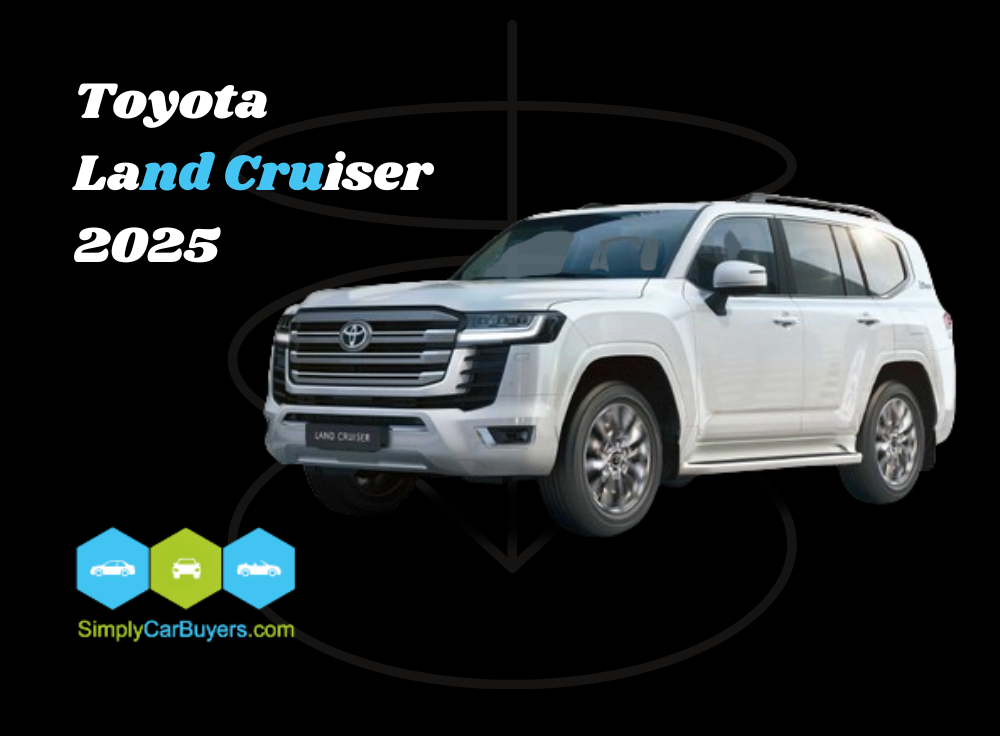
SUV Comparison UAE: Pricing & Value in the UAE Market
The Patrol 2025 starts around AED 210,000, while the Land Cruiser begins at AED 230,000. With a lower price point and more features in the base trim, the Patrol offers excellent value. Toyota, however, is known for strong resale value and long-term reliability.
Final Verdict: Best SUV for UAE Drivers?
Choosing between the Nissan Patrol and Toyota Land Cruiser 2025 depends on your priorities. If comfort, style, and affordability are key, the Patrol is the go-to SUV in the UAE. For raw power and legacy, the Land Cruiser remains unmatched.
Useful Resources:
Internal Link Suggestion: Sell your car easily in the UAE with Simply Car Buyers
Best SUVs Under AED 80,000 in the UAE
/in General /by SimplyCarBuyers.comLooking for the best SUVs under AED 80,000 in the UAE? The demand for SUVs has surged, offering budget-friendly options that combine performance, reliability, and affordability. This guide highlights top choices that deliver durability, advanced technology, and comfort for city driving and family adventures. Below, we explore the top 15 SUVs available in the UAE, focusing on value, fuel efficiency, and safety.
Key Features to Look for in Budget-Friendly SUVs
When selecting the best SUVs under AED 80,000, prioritize features that meet your daily needs and ensure long-term value. Here are the key factors to consider:
Fuel Efficiency: Opt for fuel-efficient or hybrid models to reduce operating costs.
Safety Features: Look for systems like lane-keeping assist, blind-spot detection, and collision avoidance for safer drives.
Spacious Interiors: Ample seating and cargo space make SUVs ideal for families.
Entertainment and Technology: Modern touchscreens with Apple CarPlay and Android Auto enhance the driving experience.
Top 15 SUVs Under AED 80,000 in the UAE
Here’s a curated list of the best SUVs under AED 80,000 in the UAE, balancing performance, reliability, and affordability:
1. Toyota Corolla Cross Hybrid
Price Range: AED 75,990 – 79,990 (2021 models)
Features: 1.8L hybrid engine with 138 hp, excellent fuel efficiency, and advanced safety features like lane tracing and adaptive cruise control. Perfect for families with its spacious cabin.
2. MG ZS
Price Range: Starts at AED 49,990
Features: 1.5L engine with 170 hp, sleek design, and a tech-forward interior. Ideal for city commutes and weekend getaways.
3. Toyota C-HR Hybrid
Price Range: AED 64,990 – 79,990
Features: Bold coupe-inspired design, 1.8L hybrid engine, and safety systems like pedestrian detection and advanced braking. Great for eco-conscious drivers.
4. Nissan X-Trail
Price Range: AED 69,995 – 76,990
Features: Seats up to 7, 2.5L engine, and smart safety tech like surround-view cameras. Ideal for large families.
5. Mazda CX-5
Price Range: Starts at AED 76,990
Features: Elegant design, i-Activ AWD system, and advanced safety features. Offers a premium driving experience.
6. Chevrolet Captiva
Price Range: AED 59,990 – 67,990
Features: 1.5L turbo engine, 7-seat capacity, and a 10.4-inch touchscreen. Perfect for family adventures.
7. Nissan Kicks
Price Range: AED 49,990 – 64,995
Features: Bold design, 2.0L engine, and ProPILOT tech for assisted steering and braking.
8. Honda CR-V
Price Range: Starts at AED 71,990
Features: 1.5L VTEC turbo engine with 190 hp, Honda SENSING suite, and eight airbags for top-tier safety.
9. MG RX5
Price Range: AED 49,995 – 61,990
Features: 1.5L turbo engine, modern design, and cruise control for a comfortable ride.
10. Peugeot 3008
Price Range: AED 64,990
Features: Futuristic design, i-Cockpit interior, and advanced safety features for a luxurious drive.
11. Kia Seltos
Price Range: Starts at AED 64,990
Features: 1.4L T-GDI engine with 138 hp, striking design, and excellent value.
12. Geely Coolray
Price Range: AED 69,990 – 75,990
Features: 172 hp engine, 5.8L/100km fuel efficiency, and sporty design for thrill-seekers.
13. Hyundai Creta
Price Range: AED 69,990 – 71,990
Features: 1.5L engine with 115 hp, touchscreen infotainment, and smartphone integration.
14. Kia Sportage
Price Range: AED 74,990 – 76,990
Features: Hybrid drivetrain, panoramic sunroof, and advanced safety systems.
15. Renault Koleos
Price Range: AED 52,990 – 74,995
Features: 2.5L engine, dynamic design, and R-Link 2 multimedia system with an 8.7-inch screen.
Why Choose Simply Car Buyers?
Simply Car Buyers is the go-to destination for reliable, budget-friendly SUVs. With a 99-point inspection process and a wide range of new and used vehicles, they ensure quality and transparency. Whether you need an SUV for city commutes or family adventures, their selection of the best SUVs under AED 80,000 meets diverse needs.
For those willing to stretch their budget, check out Simply Car Buyers’ guide to SUVs under AED 100,000 for more feature-rich options.
Frequently Asked Questions
What is the most cost-effective SUV?
Models like Hyundai Creta and Kia Seltos are known for low maintenance costs and affordable spare parts.
What is the most fuel-efficient SUV?
The Hyundai Creta stands out for its excellent fuel economy and affordability.
Are SUVs suitable for off-road driving?
Models like Kia Sportage and Renault Koleos offer advanced AWD systems for light off-road adventures.
🚗 Ready to upgrade or sell your current car?
Don’t wait—sell your car fast and get cash in hand with Simply Car Buyers in Dubai or Abu Dhabi. Our trusted service makes selling your car simple, with free valuations and pickup tailored to these emirates.
👉 Sell Your Car Today
📞 Call us at 800 25
📧 Email us at info@simplycarbuyers.com
📱 Follow us on Facebook for dedicated support in Dubai and Abu Dhabi
For more insights, visit Simply Car Buyers Blog.
UAE Car Events 2025 – Top 10 Auto Shows in Dubai & Abu Dhabi
/in General /by SimplyCarBuyers.comThe UAE car scene continues to grow in 2025, bringing with it an exciting lineup of exhibitions and shows for enthusiasts of all ages. Whether you’re into luxury cars, electric vehicles, off-road beasts, or vintage classics, UAE car events 2025 have something special for you.
Why Attend UAE Car Shows in 2025?
These events are more than just exhibitions—they are experiences. Car lovers, families, collectors, and tech enthusiasts all gather to witness the latest innovations and timeless classics. Attendees can explore new releases, test drive electric models, meet top dealers, and even take part in live tuning competitions.
Top 10 Must-Attend UAE Car Events 2025
Get the Most from UAE Car Events
To make the most of these car shows, it’s best to plan ahead. Book tickets early, follow event pages on social media, and consider visiting during off-peak hours for easier access. Also, bring your questions—dealers and developers are more than happy to chat about upcoming releases and technologies.
Ready to Sell Your Car Before the Event?
If you’re thinking of selling your current car before upgrading, there’s no easier way than with Simply Car Buyers.
Don’t wait—sell your car fast and get cash in hand with Simply Car Buyers in Dubai or Abu Dhabi. Our trusted service makes selling your car simple, with free valuations and pickup tailored to these emirates. Get your free quote now and see why we’re the preferred choice for car sellers in Dubai and Abu Dhabi.
👉 Sell Your Car Today
📞 Call us at 800 25
📧 Email us at info@simplycarbuyers.com
📱 Follow us on Facebook for dedicated support in Dubai and Abu Dhabi.
More Resources
For more details on international auto shows, visit Auto Show Global.
BMW X5 vs Audi A6 Comparison: Which Luxury Car Suits You?
/in General /by SimplyCarBuyers.comChoosing between the BMW X5 vs Audi A6 can be challenging for luxury car buyers. Both vehicles offer exceptional performance, elegant designs, and advanced technology, but they cater to different needs. In this detailed comparison, we explore their price, performance, specifications, and features to help you decide. With tables, a chart, and expert insights, Simply Car Buyers guides you to the perfect choice!
The BMW X5 is a standout luxury SUV, known for its powerful engines and spacious interiors. Ideal for families or adventurers, the BMW X5 vs Audi A6 comparison highlights its dynamic driving experience. Starting at approximately AED 427,000 for the M50i xDrive, it’s a premium choice. Learn more about BMW’s technology on the official BMW website.
Why Choose the Audi A6?
In the BMW X5 vs Audi A6 matchup, the Audi A6 shines as a sophisticated sedan with excellent fuel efficiency. Priced from around AED 234,100 for the 45 TFSI Quattro, it offers great value. Its sleek design and advanced infotainment make it a top pick. For details on Audi’s innovations, visit the official Audi website.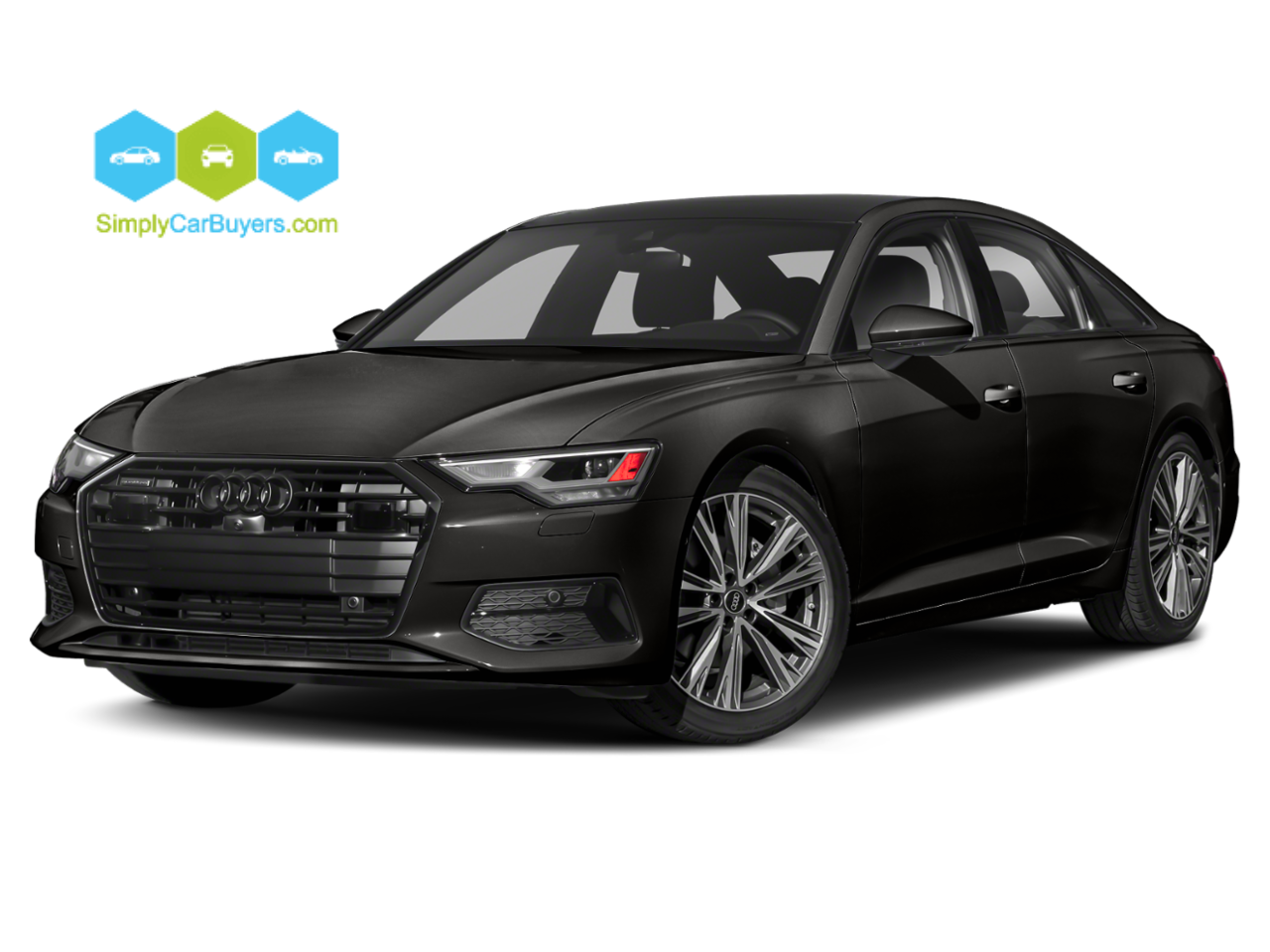
BMW X5 vs Audi A6: Key Specifications
To clarify the differences, here’s a table comparing the BMW X5 vs Audi A6 specifications:
Performance Comparison: BMW X5 vs Audi A6
The BMW X5 delivers superior performance with its 375-horsepower engine, ideal for thrill-seekers. In contrast, the Audi A6 offers a smoother ride with 261 horsepower and better fuel efficiency, perfect for daily driving. For example, the BMW X5’s all-wheel-drive system excels in rugged conditions, while the Audi A6’s Quattro system ensures stability on wet roads.
Design and Comfort
In the BMW X5 and Audi A6 design comparison, the BMW X5 boasts a bold exterior and a spacious interior with cargo space expandable to 1,870 liters. The Audi A6, however, offers a sleek, modern cabin with high-resolution displays and an advanced MMI system. Here’s a design comparison table:
Pros and Cons
Here’s a breakdown of the strengths and weaknesses in the BMW X5 and Audi A6 comparison:
Which is Better: BMW X5 or Audi A6?
The choice in the BMW vs Audi debate depends on your lifestyle. The BMW X5 is ideal for those seeking a powerful, versatile SUV, while the Audi A6 suits drivers prioritizing elegance and fuel economy. At Simply Car Buyers, we help you find the best deals. Contact us today!
Conclusion
Both the BMW X5 and Audi A6 deliver premium driving experiences, each excelling in different areas. Choose the BMW X5 for power and space, or the Audi A6 for style and efficiency. Visit Simply Car Buyers for more car comparisons and buying tips!
Car Loan Requirements in the UAE: 2025 Financing Guide
/in General /by SimplyCarBuyers.comPlanning to buy a car in Dubai or Abu Dhabi? Understanding car loan requirements in the UAE is your first step to driving away with confidence. This guide covers eligibility, documents, cost-saving tips, and how Simply Car Buyers can turn your current vehicle into instant cash to boost your down payment.
1. Why Meet Car Loan Requirements in the UAE?
Financing is popular because UAE lenders offer:
Competitive flat or profit rates
Tenures up to 60 months
Streamlined paperwork and same-day approval
Bundled insurance and registration help
Meeting every car loan requirement in the UAE up front speeds up approval and unlocks the best rates.
2. Types of Auto Loans & Their Key Requirements
New-car loans – lowest rates, 20 % down.
Used-car loans – slightly higher rates, age limits on the vehicle.
Islamic Murabaha – Shariah-compliant profit instead of interest.
Refinance – replace an expensive loan with a cheaper one.
3. Basic Car Loan Requirements in the UAE (Must-Haves)
Some lenders ask for salary transfer as an additional car loan requirement.
4. Extra Documents for Specific Profiles
Private-sector staff: stamped salary certificate.
Self-employed: trade licence + two years’ audited accounts.
New expats: signed job offer and security deposit.
5. Debt-Burden Ratio & Car Loan Requirements in the UAE
Central Bank rules cap your Debt-Burden Ratio (DBR) at 50 % of your monthly income.
Earn AED 12 000, already pay AED 2 000 on other credit? Your car instalment cannot exceed AED 4 000.
6. Tips to Meet Car Loan Requirements in the UAE & Slash Interest
Put down 25-30 % instead of the bare-minimum 20 %.
Keep your AECB score above 700.
Clear credit-card balances before applying.
Shop during Ramadan or year-end promotions.
Choose a new car—rates are always lower.
7. Sell Your Old Car First to Smooth Car Loan Requirements
Before signing the loan, turn your current car into cash with Simply Car Buyers:
Free valuation in minutes
No-fee pickup anywhere in Dubai or Abu Dhabi
Instant payment to your bank
Reducing the financed amount improves approval odds and shrinks interest costs.
👉 Get your free valuation now
8. UAE Auto-Loan Comparison (Indicative)
Rates change frequently—confirm with each bank before committing.
9. Quick Application Steps
Choose vehicle & down payment
Apply online or at a branch
Submit documents
Receive approval in 24-48 h
Arrange insurance & registration
Collect the car keys!
10. FAQs – Car Loan Requirements in the UAE
Can new expats apply? Yes—with an offer letter and, often, a larger deposit.
Is insurance included? Most lenders bundle year-one insurance.
Need a guarantor? Only if credit history is weak.
11. Key Resources for UAE Car Loans
UAE Central Bank Consumer Protection
Al Etihad Credit Bureau (AECB)

Final Thoughts on Meeting Car Loan Requirements in the UAE
Mastering car loan requirements in the UAE helps you bargain for better rates and faster approval. Combine that knowledge with a quick cash sale through Simply Car Buyers, and you’ll be behind the wheel of your new ride—stress-free and on budget.
🔥 Call to Action
Don’t wait—sell your car fast and get cash in hand with Simply Car Buyers in Dubai or Abu Dhabi. Our trusted service makes selling simple, with free valuations and pickup tailored to these emirates.
👉 Sell Your Car Today
📞 800 25
📧 info@simplycarbuyers.com
📱 Follow us on Facebook for dedicated support in Dubai and Abu Dhabi.
Sharjah to Dubai Bus Guide 2025: Routes, Fares, and Tips
/in General /by SimplyCarBuyers.comTravelling between Sharjah and Dubai has never been easier, thanks to the efficient bus services connecting these two emirates. Whether you’re a daily commuter or a visitor exploring the UAE, the Sharjah to Dubai bus guide offers a cost-effective and convenient option. At Simply Car Buyers, we’re here to help you navigate your journey with the latest routes, fares, and tips for 2025.
Why Choose the Bus for Sharjah to Dubai Travel?
The bus remains a top choice for travelling between Sharjah and Dubai. It’s affordable and reliable, with services operated by both the Dubai Roads and Transport Authority (RTA) and the Sharjah Roads and Transport Authority (SRTA). Furthermore, these buses run regularly, ensuring you can travel at a time that suits you. For example, the new Route E308, launched on May 2, 2025, connects Stadium Bus Station in Dubai to Al Jubail Bus Station in Sharjah for just AED 12 per trip.
Sharjah to Dubai Bus Routes and Timings
The RTA and SRTA offer multiple routes to cater to different areas in both emirates. The Sharjah to Dubai bus guide highlights key routes like Route E308, which operates between Stadium Bus Station in Dubai and Al Jubail Bus Station in Sharjah. Additionally, SRTA runs separate intercity services linking central Sharjah to various points in Dubai. Buses typically run at regular intervals throughout the day, making them ideal for commuters.
Fares and Payment Options
Fares for Sharjah to Dubai bus routes are budget-friendly. For instance, a one-way trip on Route E308 costs AED 12. You can pay using an RTA Nol card, which works across both RTA and SRTA services. Moreover, Nol cards can be topped up at stations or online for convenience. Always check the latest fares and service alerts through the RTA or SRTA websites to plan your trip effectively.
Tips for a Hassle-Free Commute
Here are some tips to make your Sharjah to Dubai bus journey smooth:
Other Intercity Travel Options
Besides the Sharjah to Dubai route, the UAE offers other intercity bus services. For example, you can explore the Dubai to Abu Dhabi bus routes (E100, E101, E102) or the Dubai to Hatta route for scenic travel. These routes are also operated by the RTA and SRTA, ensuring a seamless travel experience across the emirates. Learn more about these options through the RTA’s official bus guide.
Conclusion: Travel Smart with Simply Car Buyers
The Sharjah to Dubai bus guide makes commuting between these emirates simple and affordable. With regular services, budget-friendly fares, and reliable routes, you can travel with ease. At Simply Car Buyers, we’re committed to helping you navigate the UAE, whether you’re commuting by bus or managing your car needs. Avoid scams and sell your car with confidence in Dubai or Abu Dhabi. Simply Car Buyers makes it easy to sell your car in the UAE with a secure, hassle-free process. Get your free valuation today and join thousands of satisfied sellers.
👉 Sell Your Car Today
📞 Call us at 800 25
📧 Email us at info@simplycarbuyers.com
📱 Follow us on Facebook for more car-selling tips.
UAE EV Revolution: Green Future in Middle East
/in General /by SimplyCarBuyers.comThe UAE is leading the UAE EV revolution. It’s changing transport in the Middle East. The UAE uses new policies and infrastructure for a greener future. Simply Car Buyers brings you this story of change.
The Rise of the UAE EV Revolution
The UAE EV revolution is growing fast. In 2023, electric cars made up 13% of new sales. This is up from 3.2% in 2022. Dubai aims for 30% of public vehicles to be electric by 2030. Furthermore, the UAE wants 50% of all vehicles electric by 2050. The Ministry of Energy supports this goal. For example, they promote EV use across the country. This makes the UAE a leader in the Middle East.
Key Drivers of the EV Revolution in UAE
Several factors are driving Middle East sustainable transport:
These efforts make the UAE a model for sustainable transport in the Middle East. Learn more in this Al Arabiya report.
Innovative Policies in the UAE EV Revolution
The UAE uses smart policies for Middle East sustainable transport. Dubai’s Green Mobility Strategy 2030 targets 10% electric or hybrid vehicle sales. Abu Dhabi also invests in clean energy. Moreover, licenses for companies like Tesla boost private sector growth. This helps the UAE lead the region in EV adoption.
Technology and Trends in UAE EVs
New technology supports the UAE EV revolution. For instance, models like the Nio EL8 offer long ranges. Affordable options like the Wuling Mini EV attract more buyers. Therefore, the UAE’s EV market grows quickly. This diversity helps the Middle East move toward sustainability.
The Future of EVs in the Middle East
The UAE’s success inspires the region. Experts predict EV sales could reach 20% by 2027. Countries like Saudi Arabia and Oman are following the UAE’s lead. Additionally, the UAE had over 147,000 electric and hybrid vehicles by 2024. This shows a 25% increase year-on-year. The UAE EV revolution is a regional game-changer. See more insights in this Decarbonisation News article.
Why UAE Leads Middle East Sustainable Transport
The UAE balances tradition with innovation. It invests in electric trucking with companies like Einride. This multi-faceted approach makes the UAE a leader. Its efforts in the UAE EV revolution set a high standard for the Middle East.
Conclusion: Embrace the UAE’s Green Future with Simply Car Buyers
The UAE is leading Middle East sustainable transport. Its focus on EVs, infrastructure, and policy is inspiring. At Simply Car Buyers, we’re proud to support this movement by helping you buy or sell vehicles, including EVs, with ease. Visit www.simplycarbuyers.com to explore our services or get a free car valuation today. Join us in driving the green future of the Middle East!
Get a Free Valuation Now